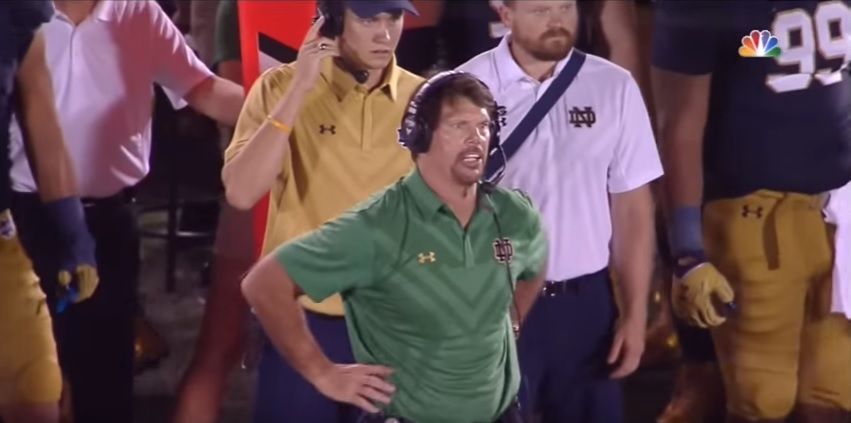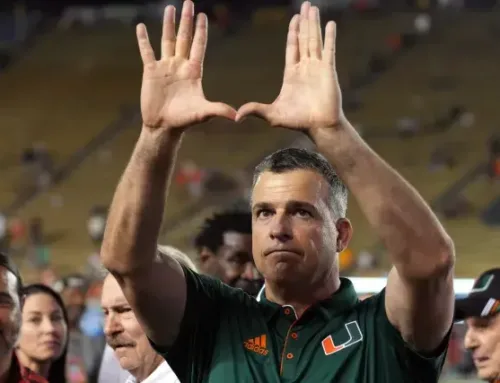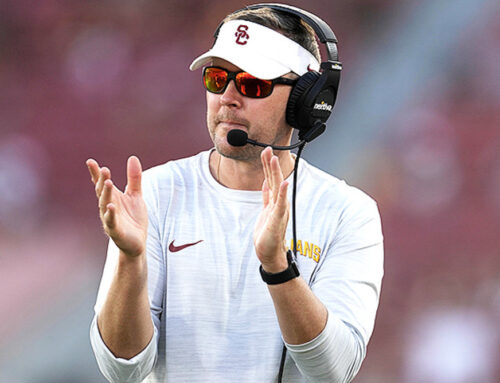What if I told you not to worry so much about the Brian VanGorder defense and its impact on the upcoming season, or even the future of Notre Dame football? You’d think I was crazy, right?
Well, I’m going to use Yards Per Play (YPP) metrics to explain why there might be more pressure on the Irish offense to perform at a high level in 2016 compared to its counterpart on the other side of the ball.
Full disclosure, I subscribe to the theory that Notre Dame’s ceiling in general is a lot higher on offense and greatness (however defined) is more likely to come from an elite offense and pretty good defense rather than seasons with elite offense and defense combined or pretty good offense and an elite defense.
Everything about Notre Dame in the second decade of this century screams out building advantages on the offense be it traditional recruiting strengths, lack of preparation time compared to other schools, or the inclination of smarter kids and which side of the ball they typically choose.
I originally had an idea for this article that intended to look at a bunch of statistics but YPP perfectly explains my theory for 2016.
Comparing offensive YPP or defensive YPP separately from different eras can be a little sketchy but I do like looking at YPP differential because that involves both sides of the ball in the equation for any given season. Here is the offense YPP, defense YPP, and overall YPP differential for Notre Dame teams since 1964:
| YEAR | OFF | DEF | +/- |
|---|---|---|---|
| 2015 | 7.0 | 5.5 | +1.5 |
| 2014 | 6.1 | 5.6 | +0.5 |
| 2013 | 6.0 | 5.1 | +0.9 |
| 2012 | 5.9 | 4.7 | +1.2 |
| 2011 | 5.9 | 5.0 | +0.9 |
| 2010 | 5.5 | 5.1 | +0.4 |
| 2009 | 6.3 | 6.1 | +0.2 |
| 2008 | 5.2 | 5.0 | +0.2 |
| 2007 | 3.5 | 4.8 | -1.3 |
| 2006 | 5.7 | 5.5 | +0.2 |
| 2005 | 6.1 | 5.9 | +0.2 |
| 2004 | 5.0 | 5.4 | -0.4 |
| 2003 | 4.6 | 5.0 | -0.4 |
| 2002 | 4.7 | 4.4 | +0.3 |
| 2001 | 4.3 | 4.9 | -0.6 |
| 2000 | 5.2 | 5.2 | E |
| 1999 | 5.9 | 5.5 | +0.4 |
| 1998 | 5.8 | 4.9 | +0.9 |
| 1997 | 5.2 | 5.3 | -0.1 |
| 1996 | 6.2 | 4.1 | +2.1 |
| 1995 | 5.8 | 5.4 | +0.4 |
| 1994 | 5.5 | 4.7 | +0.8 |
| 1993 | 6.3 | 4.6 | +1.7 |
| 1992 | 6.4 | 4.6 | +1.8 |
| 1991 | 6.6 | 5.3 | +1.3 |
| 1990 | 5.8 | 5.5 | +0.3 |
| 1989 | 5.7 | 4.3 | +1.4 |
| 1988 | 5.5 | 4.2 | +1.3 |
| 1987 | 5.3 | 4.6 | +0.7 |
| 1986 | 5.4 | 4.7 | +0.7 |
| 1985 | 4.8 | 4.8 | E |
| 1984 | 4.7 | 4.6 | +0.1 |
| 1983 | 5.9 | 4.3 | +1.6 |
| 1982 | 4.6 | 4.1 | +0.5 |
| 1981 | 4.9 | 4.3 | +0.6 |
| 1980 | 4.4 | 3.5 | +0.9 |
| 1979 | 5.4 | 4.3 | +1.1 |
| 1978 | 5.2 | 4.4 | +0.8 |
| 1977 | 5.3 | 3.5 | +1.8 |
| 1976 | 4.7 | 3.9 | +0.8 |
| 1975 | 4.6 | 4.1 | +0.5 |
| 1974 | 5.2 | 3.1 | +2.1 |
| 1973 | 5.7 | 3.3 | +2.4 |
| 1972 | 5.5 | 3.8 | +1.7 |
| 1971 | 4.0 | 3.2 | +0.8 |
| 1970 | 5.4 | 3.5 | +1.9 |
| 1969 | 5.2 | 3.5 | +1.7 |
| 1968 | 5.5 | 3.9 | +1.6 |
| 1967 | 5.0 | 3.1 | +1.9 |
| 1966 | 5.5 | 2.9 | +2.6 |
| 1965 | 4.3 | 3.2 | +1.1 |
| 1964 | 5.7 | 3.8 | +1.9 |
The first thing that jumps out from 2015 is that Notre Dame set a school record in offensive YPP last year–at least from this data I didn’t look before that but highly doubt any pre-modern offense was that explosive. Best offense of the Kelly era? Probably. Best offense since 1986? Probably not in that discussion, but really, really great at creating big plays all the same.
A second thing that jumped out to me is how important getting to at least +1.0 YPP differential in a season can be for the program. Add it up and the Irish have achieved that feat 8 times over the last 30 seasons:
1988, 1989, 1991, 1992, 1993, 1996, 2012, 2015
Notre Dame won 85 out of the 99 games in these seasons with a record of 85-13-1 overall. The game of football is too complex to be solved by just one stat but YPP differential seems to correlate fairly well for success at Notre Dame.
What does this mean for 2016?
Well, it’s super difficult to average 7 yards per play on offense even in today’s game. The Irish did finish 6th nationally in that category last year, for what it’s worth. In comparison, that once-in-a-generation defense from 2012 finished a less dominant tied for 17th nationally in YPP but made up for it with timely turnovers and superb red zone defense.
Here’s where even moderate improvement on defense could really help. Can VanGorder get the YPP number down to 5.1 or 5.2 this fall? That would put the Irish defense somewhere comfortably in the 30’s to 40’s in the national rankings, up from 64th last season. It’s difficult to imagine the defense being worse–given the talent on hand–at giving up big plays in combination with injuries from the past two seasons. Can I say this is a nice achievable expectation for 2016?
Without Fuller and Prosise I’d expect the YPP on offense to fall in 2016, although there’s a good argument to be made that a second season from Kizer and continued growth from the quarterback position keeps this stat relatively high. At any rate, I can see a -0.5 yard drop on average which would still be the second-best mark of the Kelly era.
6.5 YPP Offense minus 5.2 YPP Defense equals a +1.3 YPP differential. If we see these averages Notre Dame probably won at least 10 games and is playing in a major bowl game again.
Why is there more pressure on the offense if I’m predicting a drop in YPP? It’s because (crosses fingers) Notre Dame can’t get much worse on defense and has to improve somewhat this year with the current layout of the schedule likely to feature much tougher opponent defenses versus a sad sack opponent quarterback list full of mostly unproven or unproductive signal callers. Plus, we could get into a deep dive on the red zone woes for the offense. I’m sure everyone would take a lowered YPP if it meant a nice boost in scoring.
In a nutshell, we need the defense to rise up to be decent or maybe even pretty good while the offense needs to stay really good at minimum. In terms of expectations I’m ready for the offense to carry this team in 2016.
Here’s what the YPP has looked like for Alabama since Saban arrived:
| YEAR | OFF | DEF | +/- |
|---|---|---|---|
| 2015 | 5.8 | 4.3 | +1.5 |
| 2014 | 6.6 | 4.8 | +1.8 |
| 2013 | 7.1 | 4.8 | +2.3 |
| 2012 | 6.9 | 4.1 | +2.8 |
| 2011 | 6.4 | 3.3 | +3.1 |
| 2010 | 6.9 | 4.6 | +2.3 |
| 2009 | 5.9 | 4.0 | +1.9 |
| 2008 | 5.5 | 4.3 | +1.2 |
| 2007 | 5.0 | 5.0 | E |
It is predictably devastating to browse through, I know. Even though you could say the program peaked a few years ago they are still on a 7-year run of averaging +2.2 YPP which is insane.
That 2011 Alabama season is really difficult to compute. If you look at Notre Dame’s 3 National Championship seasons from 1966, 1973, and 1977 the Irish posted impressive +2.6, +2.4, and +1.8 YPP in those campaigns. The ’73 ND defense limited opponents to 3.3 YPP which was the same as the 2011 Alabama defense but the Tide were seven-tenths of a yard better on offense. Imagine Ara’s ’73 team averaging nearly a full yard more on offense.
I’ll tell you Lou Holtz’ legacy remains firmly intact and pristine in nature. There were defensive hiccups in 90-91 and 1995 while the offenses weren’t always great but averaging over +1.0 YPP across 11 seasons against some of the toughest schedules in school history is amazing.
That 1990 season is quite something. On the surface the YPP numbers are horrendous given the talent in the program at that point. However, they faced 7 ranked teams in a 12-game schedule and won 5 of those contests, not including a should-be win against Colorado in the Orange Bowl “Clip Game.” The Irish did finish 6th in the final AP Poll anyway, but this was a good example of how Notre Dame’s intense and difficult scheduling might have cost a legit National Championship shot.
Holtz’ swan song in 1996 hurts a lot while looking through the prism of YPP differential and is a good example that this stat is entirely fallible. This is the lone campaign over the past 42 seasons where Notre Dame reached +2.0 YPP and yet that team finished only 19th in the AP Poll with a home defeat to a 5-loss Air Force team and finale defeat to a 6-loss USC team. This is also the lone team since 1984 to average at least +1.0 YPP and not win 10 games.
The most losses with at least +1.0 YPP comes in the 1983 season complete with its 7-5 record. Just a massively underachieving team on the whole. In general, the YPP metrics stretching back to the mid-70’s aren’t real encouraging and definitely show how much Notre Dame’s dominance started to decline (with a Holtzian interruption) well before Davie or Willingham showed up. A quick look at the YPP averages by coach:
Parseghian: +1.7
Devine: +0.9
Faust: +0.5
Holtz: +1.1
Davie: +0.1
Willingham: -0.1
Weis: -0.1
Kelly: +0.9
We’ll see how much Kelly can bring Notre Dame back up into dominance in this category. His track record with YPP is strong so far albeit with weaker schedules compared to someone like Holtz.
Look at how broken the Notre Dame offenses were in the early 2000’s. Just when spread offenses began changing the game and scoring copious amount of points the Irish were stuck in the backwaters of college football. Charlie Weis brought an uptick in production but as we can see he was a one-trick pony with terrible defenses–and his offenses weren’t even that explosive, especially on the ground. It’s pretty amazing that none of Weis’ teams could get over +0.2 YPP, although I will say the 2007 defense deserves some sort of recognition. Even if opponents knew the Irish offense couldn’t gain a first down just being able to limit opponent offenses to 4.8 YPP is a miracle to behold.
The 2002 Return to Glory™ looks so silly in retrospect with a 4.7 offensive YPP. Somehow that ’02 offense is only tied for the 8th worst YPP since 1964 for Notre Dame. Like I said, offensive backwaters for so many years.
Of course it was a different era and his entire reign was against some weak schedules (no bowl games in the first half of his tenure especially) but Parseghian went 11 years with nothing over 4.1 YPP on defense. It’s still pretty amazing.
There are some knock ’em out drag ’em out type of seasons from the past that must have been brutal to watch. Look at 1965, for example. That season featured 74.4% running in all Notre Dame games and 82.7% rushing from the Irish offense. So. Many. Fullbacks.




